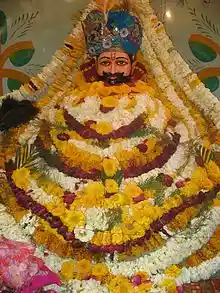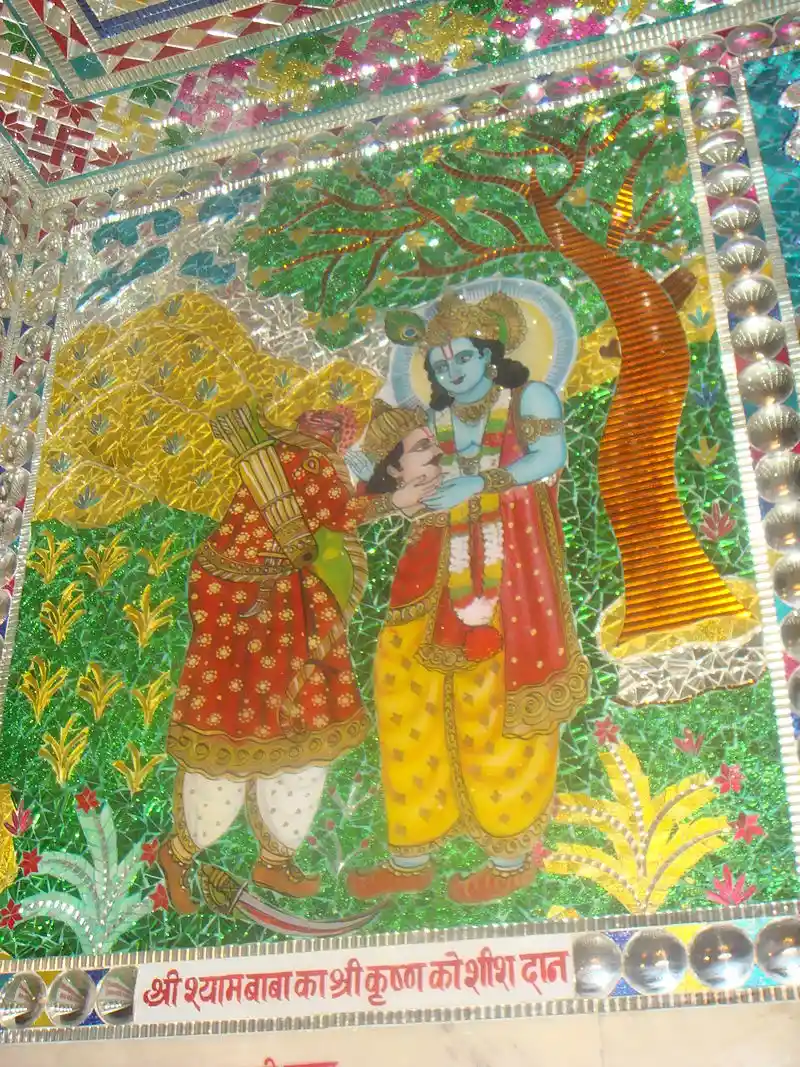Barbarik's Sacrifice
Before the war of Mahabharata started, a lone warrior secured his position in the epic by giving the ultimate sacrifice. Arguably, many mythological writers consider him the most powerful warrior in the epic of Mahabharata. And yet, he never participated in the war itself. Quite a title for such a scarcely known character, isn't it? This warrior was none other than the grandson of legendary Bhima and Hidimba and the son of Ghatotkach and Maurvi.

Barbarik is also worshipped as Khatushyam in parts of India; Image source: Wikipedia
The tale of this hero started long before his birth. As per the story in Skanda Purana, His mother, Maurvi, was the daughter of Mura, an avid supporter of Narakasura. And yes. He is the same Narakasura, who was defeated and killed by Lord Krishna and Satyabhama. Lord Krishna also killed Mura as he fought alongside Narakasura. When Maurvi got this information, she was filled with rage and went to fight Lord Krishna. As soon as she faced him, she realized who he was and dropped her weapons. And thus, Lord Krishna blessed her that she would get married soon. Unfortunately, Maurvi had a vow to only marry a man who could defeat her in battle. It took a while, but finally, Ghatotkacha defeated her in battle, and they got married.
In some folk variations of the story, Maurvi is known as Ahilawati and is the daughter of Vasuki, the King of Nagas. When the treacherous Shakuni poisons Bheema and throws him in a river, an unconscious Bheem reaches the kingdom of Nagas, there Ahilawati saves his life, and in turn, Bheem offers her the hand of his son Ghatotkach.
From this union, Barbarik was born. In his previous birth, he was a Yaksha named Yavarcha. When the earth was under tremendous pressure due to increased evil, Lord Brahma approached Lord Vishnu to help humans. Lord Vishnu replied that he would incarnate in human form at an appropriate time. When Yaksharaj Yavarcha heard this, he said that Lord Vishnu doesn't need to incarnate as he alone can end all the evil on earth by himself. This proclamation angered Lord Brahma, and he cursed Yavarcha to take birth in human form and die at the hands of Lord Vishnu.
Now, let's jump to the setup of Mahabharata right before the war. The story of Barbarika is usually found in the regional variants of the epic Mahabharata and folklore. While the preparation of Mahabharata was going on, Yudhistira asked his fellow warriors how much time would they take to finish the war?
In some variants, Krishna poses the same question. Arjuna, the great archer, boasted that he could end the war in one day. Barbarik felt insulted by Arjuna's arrogance and said he could finish the fight in one minute and with just 3 arrows.
These weren't any regular arrows; Barbarika had received 3 divine arrows as a boon from Lord Shiva. In some variants of the story, they are given to him by Lady Sidhambika. Barbarik's first arrow marked all his enemies. The second arrow marked all his friends and the third arrow destroyed all the enemies marked by the first arrow. No matter where they are.
Lord Krishna approached Barbarik to test his potential. They were standing in front of a tree that had a mix of green and yellow leaves. Lord Krishna asked Barbarik to pierce all the tree's green leaves, leaving the other leaves intact. With the first arrow, Barbarik marked all the green leaves of the tree. With his second arrow, he marked all the yellow leaves of the tree. And with his third arrow, he pierced all the marked leaves. But to test his capability, Lord Krishna kept a green leaf from the tree hidden under his foot. After Barbarik's last arrow pierced every green leaf, it stopped at Krishna's foot and started hovering over it. Barbarik asked Krishna to kindly move his foot; otherwise, the arrow would pierce it. In some variants of the story, the arrow goes through Lord Krishna's foot to pierce the hidden leaf.
And with this, Lord Krishna realized that Barbarik might end the war with just three arrows. But Barbarik had taken a vow to always fight for the weaker side. Lord Krishna pointed out that whichever side is he fighting for would automatically become the more powerful side. And hence, he won't be able to fight in the war. Having said that, Barbarik agreed to not take part in the war.
Lord Krishna asked him to give his head as a sacrifice since the head of the bravest Kshatriya was needed to bless the battlefield and bless Pandavas side with victory. Barbarik readily agreed to it. But he expressed his desire to watch the entire war of Mahabharata. Lord Krishna used his Sudarshan Chakra to sever Barbarik's head from his body but granted immortality to his head. He placed Barbarik's head at the top of a hill near the battlefield. Thus Barbarik was able to watch the entire war even without a body.
In the present time, he is worshipped as Khatushyam in Rajasthan and Baliyadev in Gujarat. A local legend in Rajasthan states that after the end of the Mahabharata war, Krishna drowned the head of Barbarik in the Rupwati river. The head remained lost until the Kali Yuga, buried near Khatu village in Rajasthan. Legend states that Roopsingh Chauhan, the king of Khatu, had a dream that inspired him to build a temple and install the head there. The temple today is known as the famous Khatushyam temple. And Khatushyam is the family deity of many families in Rajasthan.
This story has many regional variations and folklore and can vary from place to place. Nonetheless, Barbarik remains an important figure in the epic of Mahabharata whose sacrifice and bravery should be remembered.

A temple art depicting Barbik’s sacrifice; Image source: Wikipedia


